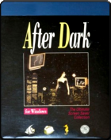THE HISTORY OF SCREENSAVERS
It all started when we discovered an opportunity to create a new product. By engaging with users,
we defined a new market and created incredibly lucrative products that satisfied millions of users.
Like all great UX work, we started with a hypothesis and kept making improvements based on user feedback.
THE SHORT VERSION OF THE STORY
It all started with animation experiments by Bill Stewart and Ian MacDonald. We shared an experiment online and named it Magic.
Users started paying for it without being asked, but also made numerous requests and sent bug reports.
Through many iterative improvement sprints, Magic became a huge hit that made a lot of money.
We organized our growing team around making rapid iterative changes reflecting ongoing findings about our users. We built customer personas and prioritized task lists from those findiings.
Rapid iterative releases led to Magic's quickly exploding base of paying customers.
By following our research, we ended up Aadding password protection that made Magic the first way to lock down a PC.
The combination of saving screens from replacement and protecting company data, became a killer feature set,
with companies seeing a 15-20x ROI on purchasing Magic. This made it incredibly easy to sell large licenses.
As we perfected the product and licensing model, Magic became incredibly lucrative and licensed by the biggest companies
and governments in the world.
Since our freeware experiment was making money hand over fist with no advertising or consumer reach, we outsourced sales
to a publisher to get it in stores.
We scaled it up with funny animations like Flying Toasters and changed the name to After Dark.
After Dark quickly became the top-selling software product in the world.
We sold more copies than Microsoft Word, Mac computers and even Windows itself for a time.
SUMMARY
Even the most smallest thing can evolve into a worldwide success if you collect good data from users, then analyze, execute and iterate.
The following links will take you to the full story.

MAGIC SCREENSAVER - LIGHTNING IN A BOTTLE
The idea of paying for a screensaver may seem weird now, but it was 10x weirder back in the late 1980s. Computers were
slow. Graphical interfaces were a relatively new thing which made computers slower.
You could get a cup of coffee, do jumping jacks or discuss politics while waiting for a big spreadsheet to update.
Why would anyone want to pay for software
running in the background, slowing their computer even more, that showed animated graphics
when they weren't even there to see it?
Screensavers seemed to make no sense, even as a free product. We discovered an opportunity that didn't seem to exist.
We had relatively boring contract work, so we experimented with graphic animated infographics to make data more exciting
and easier to understand.
It is easier to find something good if you see lots of variations.
We rigged up automated animation tests with changing animations as a screensaver.
We liked one of the animations with mesmerizing interference patterns, so we posted it online as freeware.
Just for fun, Bill called it Magic. It felt magical because it *seemed* to sync with music
and calm the mind. We then forgot about it and went back to serious work.
Within a few weeks, letters starting arriving from Magic users, complaining about bugs, but also sending case and cheques to pay for it.
With no price list, users guessed at the price, sending us between $20-$100.
We didn't quite realize what we had, but felt a moral obligation to fix bugs and make it better. It was exciting having fans.
Every time we released a new version, our fan mail and revenue leaped higher.

THE SECRET OF OUR SUCCESS: EVOLUTION OF THE SCREENSAVER PRODUCT
Even negative user feedback reveals opportunities.
We’d never built anything that motivated people to send us letters, much less SEND US MONEY for BUGGY SOFTWARE.
We settled into a rapid research, develop, test, and release cycle that caused a SIZZLE!
We received a lot more letters, bug reports, and money. We fixed the bugs and set a pricing scale.
BOOM! Suddenly our mailbox and email box was overflowing every morning with fan letters, all with cheques or cash.
We talked to users to figure it out.
We identified several important product factors:
- Why is this valuable to users?
- How can we ensure that the screensaver won't mess up other software running on the computer?
- Who are our customers? What is their environment? How do they justify purchasing it?
- What features can we add that add genuine value for our most important types of users?
- How can we lower the cost of ownership (beyond simple purchase price)?
We collected and organized user feedback to answer these questions. We discovered that we had a two-pronged value prop.
1. Users enjoyed the soothing animation and the simplicity of the product's interface. In an age when almost all software
was a painful mess to use, using Magic was a step into a more elegant world.
Magic engaged automatically and went away with a wave of the mouse. It's configuration panel was designed to be highly usable.
That was very unusual back then.
2. Users really *needed* Magic to save their screens. At that time, every screen was vulnerable to burn in if you didn't buy a screensaver.
We needed to make it easier to justify purchases.
Solving problems isn't that bad when you realize what's really important to solve.
We tweaked and redesigned it through dozens of iterations until it was a seamless and near-perfect user experience.
MAXIMIZE PRODUCT ROI
If you want to sell to business customers, your product needs a high return on investment (ROI).
If you wonder how a screensaver could have an ROI, let me unpack it for you. A typical screen cost $300-$600.
At the time, every screen was vulnerable to burn in if you didn't buy a screensaver. That's a lot of cost saving.
We also introduced the first password locking system into the Magic screensaver.
The value of protecting company data was worth even more preventing screens from burn in.
We figured these things out in consultation with our paying customers and then organized that into a sales sheet that
showed typical companies achieved 15-20x ROI from licensing Magic for all their computers in the first year.
Magic was ready to step up. All we had to do was open the gates to let it grow.
We spelled out the ROI for customers, made it easier for international buyers and built a sliding fee scale for site licenses.
We tuned performance and refined the wrap-around password protection to lock up a PC.
We also sought out more ways to distribute the trial version to online services, computer books and journalists everywhere.

GOING COMMERCIAL - MAGIC BECOMES AFTER DARK
Business was booming, but without marketing, we knew we were only scratching the surface. We had vision.
Selling upwards of 85,000 copies of Magic was only the TIP OF THE ICEBERG.
At the time, Bill Stewart said that "If we can get this into stores, I'm certain it will sell millions."
Instead of just riding the money train, we started Magic 2.0 with a modular design for different animations
and user contributions in line with our user research. We started building a collection of novel animations.
We had a huge user response to our announcement of a coming module developer's kit so that users could make their own screen savers.
It also sparked many requests for us to develop custom screensavers for corporate clients.
We had just started setting up deals with international companies to distribute and sell Magic in local currencies.
We scaled Magic up with funny animations like Flying Toasters and changed the name to After Dark.
The working title for the new product was "Magic After Dark", but we simplified to just "After Dark"
to differentiate the new product from what we'd already done.
We chose Berkeley Systems as a small company we could outsources sales and marketing to so we could concentrate on designing and developing
the ULTIMATE SCREENSAVER. We led the design and development teams to create the world's #1 most popular and profitable software.
There were many well-produced competing products that failed in comparison. Our focus on offering the best user experience
made our product be valued far higher by our loyal fans than any competitor.
Matching us animation for animation and feature for feature DIDN'T ADD UP TO ANYTHING because we were the only ones who understood
a) why people wanted and needed the product and b) recognized the value of delivering an awesome user experience.
The average person felt you had to be a genius to work a computer. After Dark showed that normal people could enjoy software.

WHAT WE LEARNED
We loved creating a pop culture item featured in comic strips,
tv shows and movies as something universally recognized. It was nice to hear from designers that our approach
to usability and low cost of ownership was influential. These were great things. Learn more from the links below:
